Roast Chicken fills you with a sense of accomplishment the night you have cooked it. This night we decided to try it by adding some Masala to cook Roast Chicken Masala.
We first tried cooking roast chicken after watching a Chef Thomas Keller video on Bouchon Bistro’s Roast chicken. It is one of the most rewarding recipes and can be found in the Bouchon cookbook. It can seem daunting to begin with, but with repeating comes habit and confidence.
If you watch the video carefully i love the satisfied smile when the two chefs take a bite, nod at each other and say “Roast Chicken”. There is a satisfaction in the end of biting into a juicy piece with seasoned crispy skin. Pair it with roast vegetables of the season and it becomes such a soulful plate.
There is always an instinct to add Masala to anything and everything we come across. That is something that should be practiced with caution though. I have always wondered how it would taste but also worried of ruining the subtlety and nuance of some flavors. In Indian cooking chicken is most times marinated with an acidic lime and yogurt paste. However most times this is done to chicken without the skin on. This marinade definitely leaves the skin very moist and it does not crisp up easily in the end. I am still known to eat it but my wife would literally scrape the skin off with her fork if i ever present her with a sub par job with the skin. That annoys me fairly in that moment as she scrapes off more than a hours work but deep down i do know she is right. Thus when roasting the chicken if i was going to use Masala, i could not risk doing it by compromising the crispiness of the chicken skin. So when thinking of doing our Roast chicken Masala i did not want to make a wet marinade if i was going to leave the skin on. I decided to use the masala as a dry seasoning and let the chicken fat crisp the skin as well as Masala. My worry now was that this may burn the masala and it was a risk i took. However thankfully it did not and our roast chicken masala turned out perfectly in the end resulting in sort of aromatic roasted seasoning on the skin.
Masala really is a blend of spices or seasonings. I made mine with the sweet spices cloves and cinnamon, paired with aromatic cardamom and nutmeg alongwith some mace. I also used a few coriander seeds and black peppercorns and i ground all these up in my coffee/spice grinder. I then mixed in coarse sea salt and kashmiri red chili powder. Kashmiri red chili powder is intensely red in color yet in taste is fruity compared to other chilies and packs less heat.
Make sure you buy good quality roast chicken which has not seen the freezer. Was the chicken inside and outside thoroughly and pat it absolutely dry and let it rest to come to room temperature which is tip from Chef Keller. Make sure to remove the wishbone as it makes later carving easier.
I seasoned the cavity really well as well as stuffed the cavity for aromatics with crushed garlic and ginger and cilantro stems all doused in some mustard oil (optional) and also stuffed a forked lime to fill the cavity up. I have heard this helps cook the bird evenly increasing the core mass and also possibly steams the inside a little bit keeping it juicy.
I then trussed the bird and then seasoned it heavily with my masala salt blend. I also added a sprinkling of kasuri methi which are dried methi (fenugreek) leaves which we talked about in our earlier post.
I would have loved to use more root vegetables like carrots, turnips, squashes and potatoes and also pearl onions. However it was Christmas eve and all shops were closed and we cooked the meal with whatever we had on hand, which was essentially onions which i pan roasted along-with the chicken. With the oven preheated and the trussed chicken in the pan over a bed of onions, it was ready to roast.
We cooked for about 40 minutes checking the temperature and watching the chicken get crispy. We did not do any basting since the bird seemed juicy and the skin was not overly burning and neither was the masala. We checked the temperature of the legs and when it was 155 we took the chicken out and let it cook further on its own gradually the temperature reaching 165. We collected considerable chicken jus in the roasting pan which we collected and strained into a pan and reduced to almost half. This chicken au jus is absolutely filled with flavor and is like liquid gold.
We cut off the trussing and removed the stuffing. Having lusted over the pictures of roast duck at eleven madison park and roast chicken at nomad we decorated our roast chicken masala with some cilantro and mint appropriate for an indian inspired chicken to look pretty in our pan before being carved.
Meanwhile we prepared some tomato and butter sauce. We added a teaspoon of butter, one onion and two tomatoes cut in half, 4 garlic pods, 4 cashews and two cardamom pods and pressure cooked without any additional water on medium heat for about 15 minutes. Typically you don’t pressure cook without adding water but both the onion and tomatoes create lot of liquid that it kind of steams and cooks getting a bit caramelized bringing out the loveliness of the sugars in the tomatoes and onions. Alternatively you can cook this in covered pan with some water and a sprinkling of sugar with lid on for 30 minutes. We then removed the cardamom pods and pureed the mixture and strained it to get a silky soft puree. We melted in a teaspoon of cold butter and some salt for seasoning.
We then carved the breast and removed the wing as well as carved the leg. We spooned some of our tomato butter sauce on the plate and topped it with some roast onions. We drizzled some of the chicken au jus on top. We topped it with our carved chicken and also drizzled some jus over top. We garnished with some flaky maldon sea salt and just a little bit of cilantro. When we dug into our Roast Chicken Masala we absolutely enjoyed the crispy, seasoned skin with the crackling salt flakes and the juicy chicken paired with slight acidity of the tomato butter sauce. This Roast chicken masala is a good way to mix things up when roasting chicken although a simply roasted chicken is also finger licking good by itself.
We would eat a well made roast chicken in a restaurant in a heartbeat. In fact we would most likely go there often. With more and more grocery stores stocking the rotisserie chickens and customers responding favorably to them because of the convenience, we have seen slow withdrawal of roast chicken from many menus. The wide spread presence of boneless skinless chicken breasts on all menus for health reasons has also contributed am sure. Yet it can be such a simple, delicious and hearty meal paired with seasonal produce that i do yearn for it, and most time the only option is to make it ourselves.
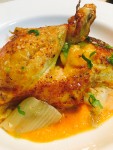
Roast Chicken Masala
- Total Time: 2 hours
- Yield: serves 2 to 4 1x
Description
We Roast a whole chicken with dry masala seasoning. We serve our Roast Chicken Masala on top of a tomato butter sauce, roast onions and with drizzle of chicken au jus
Ingredients
- 1 whole roasting chicken
- For the seasoning:
- 2 cardamom 4 cloves
- 0.5 inch cinnamon
- 0.5 petal of mace
- 0.4 black peppercorns
- 0.5 tsp grated nutmeg
- 1 tsp kashmiri chili powder
- 2 tsp coarse sea salt
- 1 tsp kasuri methi leaves
- For the stuffing:
- 1 lime pierced all over with a fork or a knife
- 4 garlic pods smashed
- 1 inch ginger smashed
- 2 sprigs of cilantro
- 1 tsp mustard oil
- For the tomato butter sauce:
- 1 onion
- 2 tomatoes
- 4 garlic pods peeled
- 4 whole cashews
- 2 green cardamoms whole
- 2 tsp butter
- For the garnish:
- 1 tsp cilantro chopped
- 0.5 tsp flaky maldon sea salt
Instructions
- Wash the whole chicken with water inside and out
- Thoroughly pat dry
- Remove the wishbone
- Let rest till it tempers to room temperature
- Preheat oven to 475F
- Prepare Masala seasoning by grinding the dry spices in a spice/coffee grinder reserved for spices and then mixing in the salt and red chilli powder
- Season the cavity liberally with masala seasoning by sprinkling it in.
- Stuff the pierced lime followed by garlic and ginger and cilantro doused in mustard oil
- Truss the chicken
- Liberally season the chicken by sprinkling the masala seasoning all over
- Also sprinkle the kasuri methi leaves all over
- Add roasting onions chopped into quarters to the pan to form a bed
- Rest the chicken on top, breast up
- Put the pan in the oven and cook for 40 mins and chek the temperature of the legs using a thermometer
- Remove the pan when it says 155F, and allow it to rest as it cooks up to 165 with the residual heat continuing the cooking
- Strain the juices collected in the roasting pan into a different pan and reduce to half till the start coating the back of a spoon to obtain the chicken au jus
- Stir in some butter and reduce them further to get a shiny coat on spoon
- Pressure cook peeled and halved onion, two halved tomatoes, garlic, cashews, 1 tsp butter and cardamom seeds on medium heat with lid on for 15 minutes
- Let the pressure dissipate and open the lid and remove cardamom pods and puree the rest. Strain this to obtain a silky puree without any tomato skin. Stir in 1 tsp cold butter and salt to taste to get the tomato butter sauce
- Carve the chicken
- For serving spoon some tomato butter sauce on the plate. Add some roasted onions. Drizzle some chicken au jus and add the chicken on top. Drizzle a bit more of the chicken au jus and garnish with the flaky sea salt and some chopped cilantro.
- Prep Time: 60 mins
- Cook Time: 60 mins
- Category: Dinner
- Cuisine: Indian American


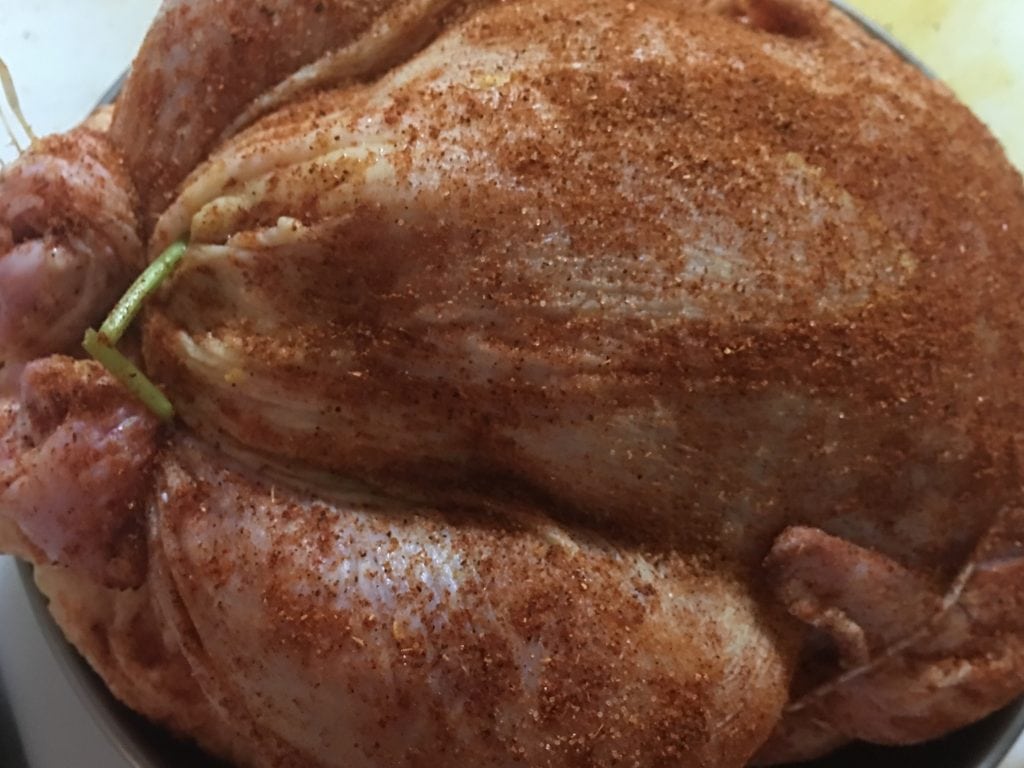
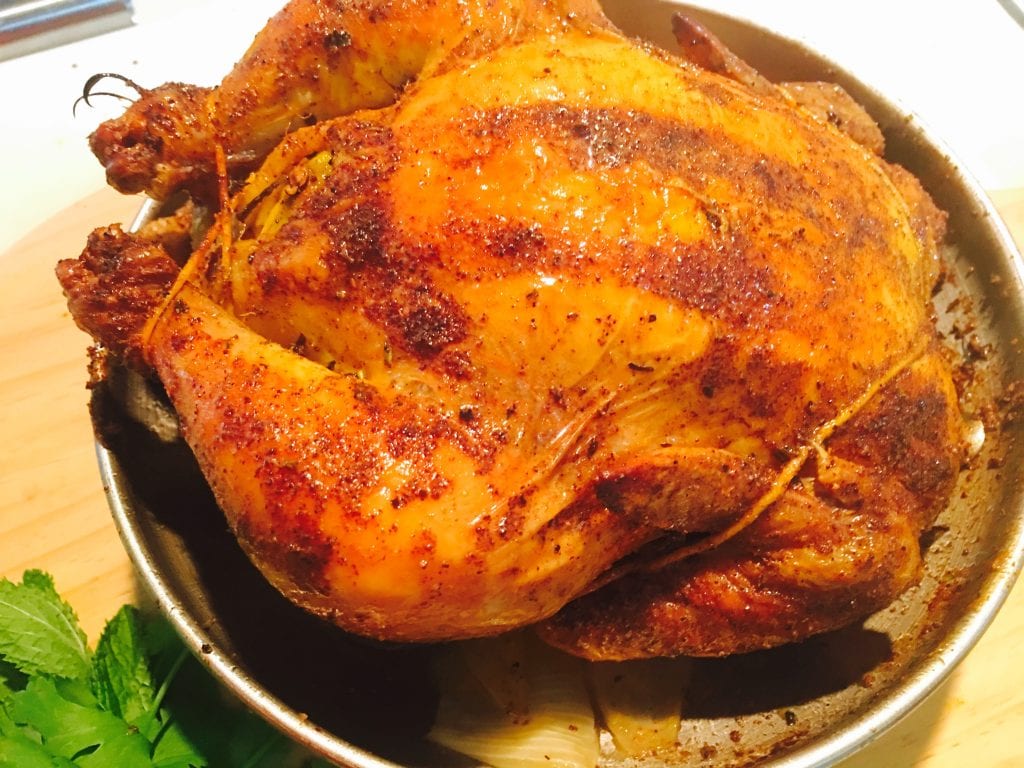
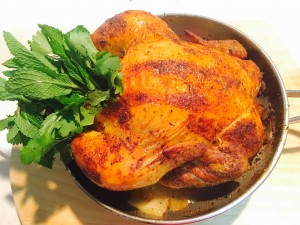
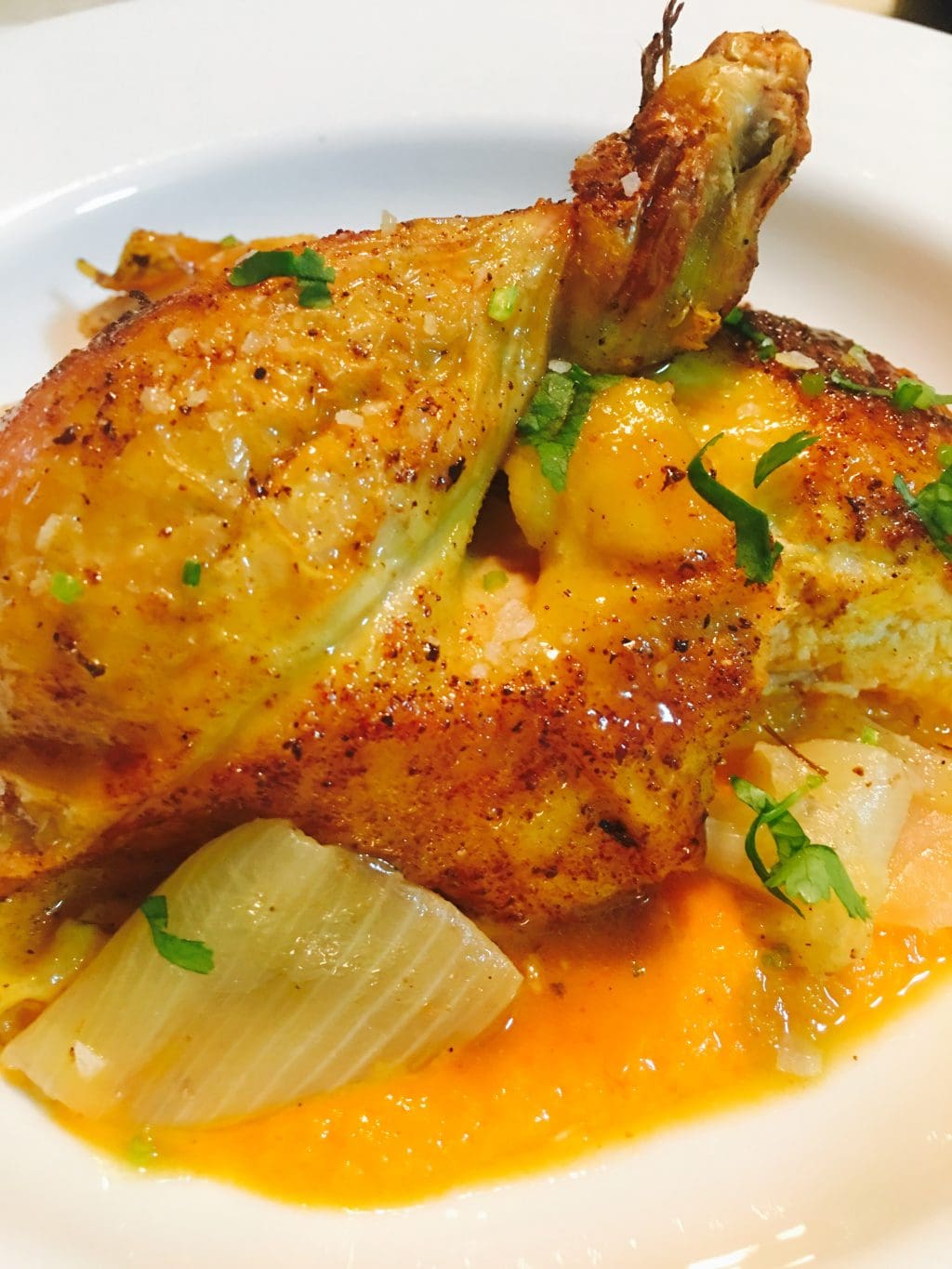
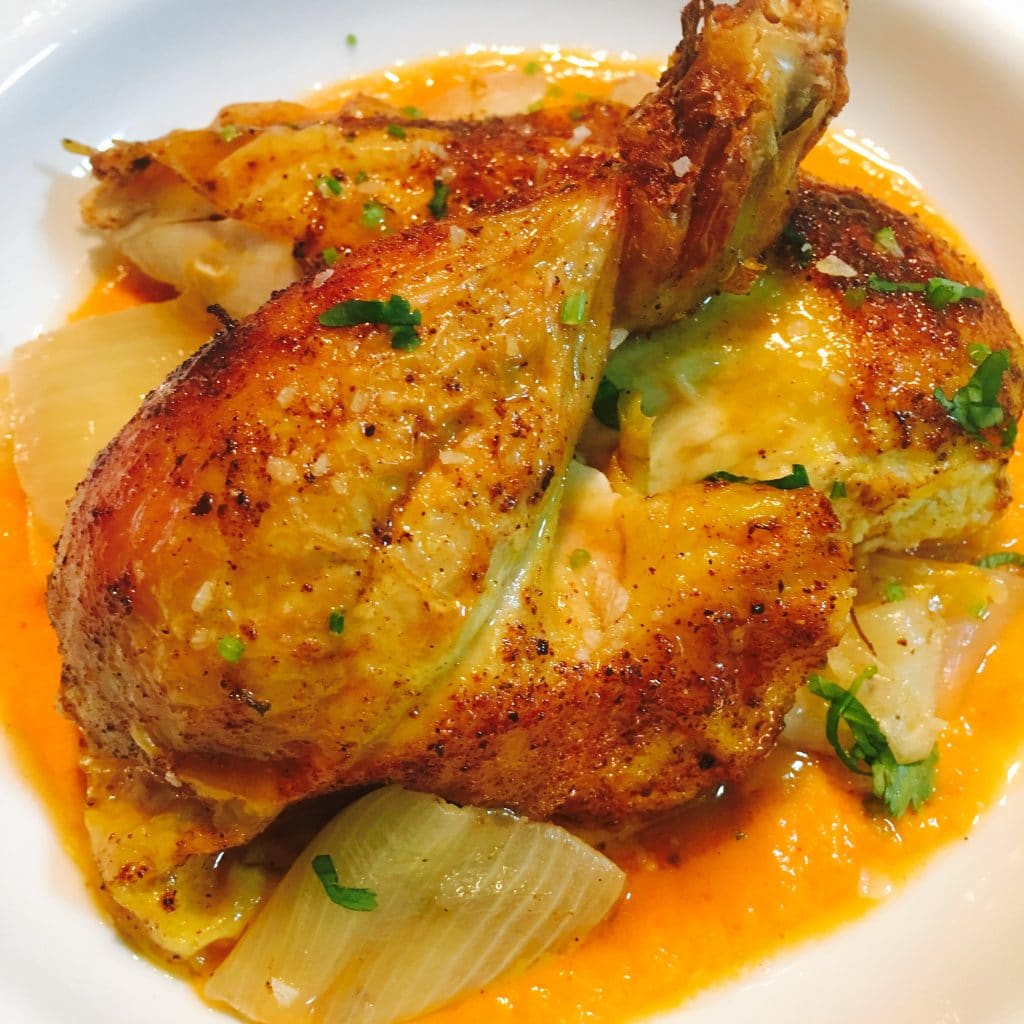
Hi Meghana and Vikram .
That was very detailed and insightful .
Some things that stayed —
* Aai ( mother in Marathi ) had given me a mantra which has stayed for life – when you set out to cook and circumstantial do not have all the ingredients you must do your best to create a winner with the available ingredients at hand making the most of them . This helps you immensely in thinking out of the box when presented with such a situation and you succeeded .
* your conviction in using some things – like sprinkling of the masala on the skin – it’s associated risks – but constantly checking on the temperature / varying the process – made it a success . That’s evaluating your risks – understanding them – could Teri g them – and succeeding .
* Using seasonal produce – the so called flowering season ( not necessarily flowers ) is when these products are at their best in terms of their active principles – giving the best on two fronts – nutritionally and taste-wise too .
* Using the collected juices to make the jus – utilising the liquid gold .
* And your concerted efforts in explaining the details , nuances when cooking – making it a pleasant / compelling / inspiring read and not just a technical recipe .
Well done . Good wishes always .
★★★★
Thanks for your insights and appreciation Uday, moms teach us well 🙂
I need to make these as an appetizer for my fundraiser they would go crazy of these!